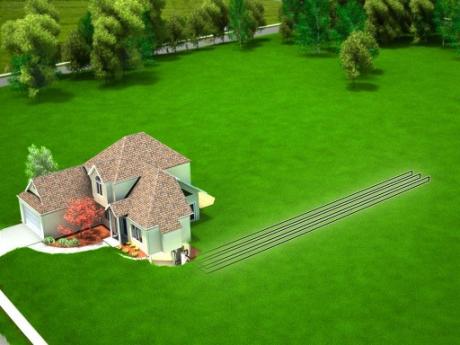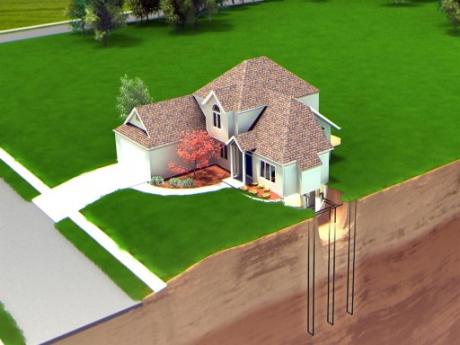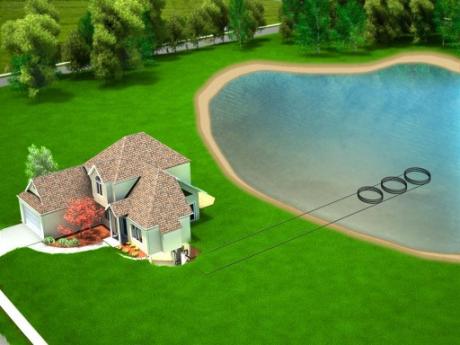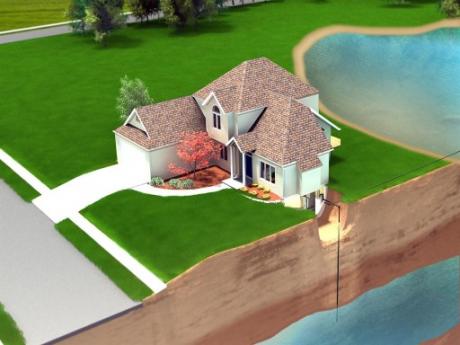Understanding Earth Loops
Earth loops are right at the heart of a geothermal system. They constitute its biggest advantage over conventional heating and cooling technologies. So, what exactly does an earth loop do? It transfers heat to and from the ground – eliminating the need for fossil fuels.
Earth loops come in two basic types. The type you use depends on the terrain, the cost of trenching or drilling, the availability of quality ground water, and what space is available.
- Closed loops are buried in the earth or submerged in a lake or pond. They transfer heat by circulating a solution of water and environmentally safe antifreeze.
- Open loops use ground water pumped from a well as a heat source.
Horizontal Trench Loops
 If you have enough useable land, horizontal loops (as seen in image) can be installed. This is done by digging trenches with a backhoe or a chain trencher. Then, you insert polyethylene pipes backfill the trenches. Various horizontal loop configurations are possible, using one, two, or three circuits per trench. The more pipes you have in each trench, the shorter the trench can be. Trenches normally range from 100 to 300 feet, depending on the design. A typical home requires one to three quarters of an acre for the trenches.
If you have enough useable land, horizontal loops (as seen in image) can be installed. This is done by digging trenches with a backhoe or a chain trencher. Then, you insert polyethylene pipes backfill the trenches. Various horizontal loop configurations are possible, using one, two, or three circuits per trench. The more pipes you have in each trench, the shorter the trench can be. Trenches normally range from 100 to 300 feet, depending on the design. A typical home requires one to three quarters of an acre for the trenches.
A variation on the horizontal loop is the horizontal bore loop. This type of loop is most often used in a retrofit situation to minimize disruption to the landscape. It requires special equipment to bore holes horizontally under the surface. The operator can “steer” the drill head to go deeper or shallower, or turn right or left. This machine drills at a slight angle down to a typical depth of 10 to 12 feet then back to the surface, typically 200 feet away. At that point, two ends of pipe are attached to the drill bit and pulled back through the hole until the pipe is buried. This technique allows the loop to be placed.
Vertical Loops
 Vertical loops are used where space is limited or where soil conditions make horizontal loops impractical. A drilling rig will bore multiple holes approximaely 10 feet apart, then a double pipe is connected with a U-bend into each hole. Each hole is filled with grout to seal it and provide good contact around the pipe. Each pipe is connected to a header system horizontally a few feet below the surface. The depth of the holes is dependent upon soil/rock conditions and the size of the system. Although most holes are bored about 100 to 250 feet deep, there’s no “magic depth” that needs to be reached. Capacity is not based on depth; rather how much pipe is in the ground and the overall thermal conductivity of the borehole.
Vertical loops are used where space is limited or where soil conditions make horizontal loops impractical. A drilling rig will bore multiple holes approximaely 10 feet apart, then a double pipe is connected with a U-bend into each hole. Each hole is filled with grout to seal it and provide good contact around the pipe. Each pipe is connected to a header system horizontally a few feet below the surface. The depth of the holes is dependent upon soil/rock conditions and the size of the system. Although most holes are bored about 100 to 250 feet deep, there’s no “magic depth” that needs to be reached. Capacity is not based on depth; rather how much pipe is in the ground and the overall thermal conductivity of the borehole.
Pond Loops
 If an adequately sized body of water is close to property, we can install a pond loop. A half acre, eight foot deep pond is usually sufficient for the average home. Ideally, the pond should be less than 200 feet from the home. If the pond is farther from the home, the benefit of using a pond loop is reduced due to added trenching, materials, and pumping costs.
If an adequately sized body of water is close to property, we can install a pond loop. A half acre, eight foot deep pond is usually sufficient for the average home. Ideally, the pond should be less than 200 feet from the home. If the pond is farther from the home, the benefit of using a pond loop is reduced due to added trenching, materials, and pumping costs.
A series of sealed pipes containing a mixture of water and antifreeze are coiled on dry land, then sunk to the bottom. (Using pond water directly is never recommended.) Generally, a 300 foot coil is used for each ton of capacity. This is less pipe than is used in an earth loop, because water is a better conductor of heat energy. Pond loops are a cost-effective way to install a geothermal system, because trenching is limited to only the supply and return piping from the pond to the house.
Open Loop (Well System)
 If an abundant supply of quality well water is available, an open loop system can be installed. A proper discharge site, such as a ditch, field tile, stream, or pond must also be available. Be sure to check all local codes before selecting a discharge method. This installation usually costs less and delivers the same high efficiency since groundwater maintains a relatively constant temperature year-round. Depending on water quality, periodic cleaning of the heat exchanger inside the unit may be necessary. Well water containing too many contaminants may not be suitable for use with a geothermal system, as it may cause the unit’s performance to degrade over time. Proper testing of the water prior to installation is required.
If an abundant supply of quality well water is available, an open loop system can be installed. A proper discharge site, such as a ditch, field tile, stream, or pond must also be available. Be sure to check all local codes before selecting a discharge method. This installation usually costs less and delivers the same high efficiency since groundwater maintains a relatively constant temperature year-round. Depending on water quality, periodic cleaning of the heat exchanger inside the unit may be necessary. Well water containing too many contaminants may not be suitable for use with a geothermal system, as it may cause the unit’s performance to degrade over time. Proper testing of the water prior to installation is required.
Contact us to determine which geothermal system would work best for your property.
